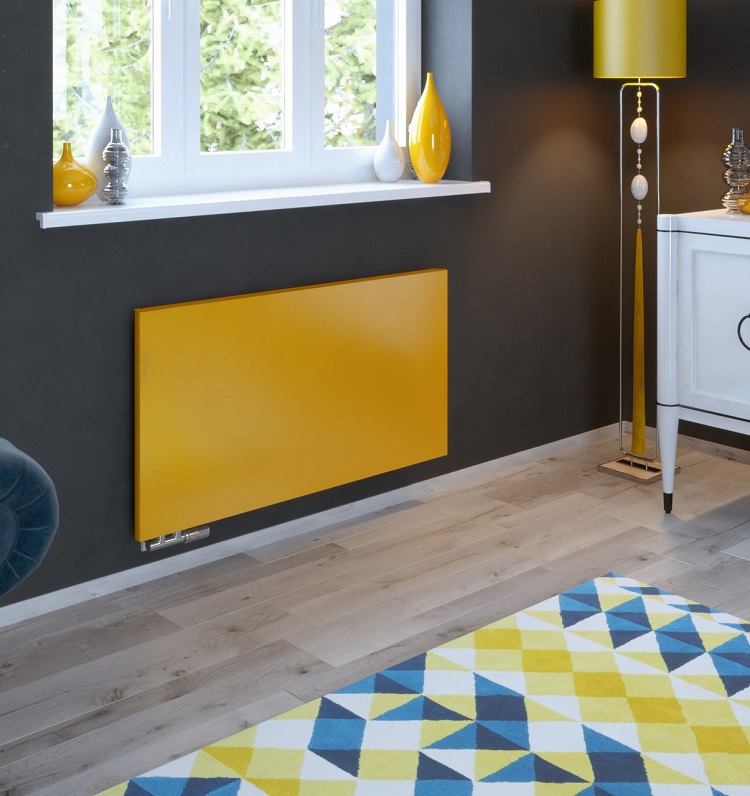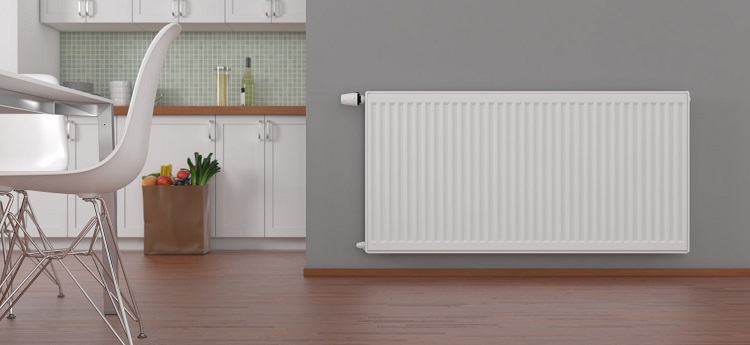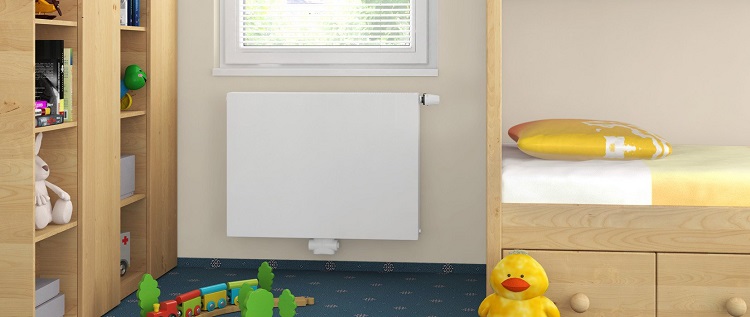A large selection of steel batteries often leads to bewilderment of potential buyers who do not know which ones are the best. Panel radiators are consistently snapping up. Their demand is justified, thanks to the affordable price and excellent design. Steel models have their own excellent properties and shortcomings, which are important to know about before making a purchase.
Content
Design features of panel-type heating batteries
Panel steel heating radiators are a relatively new offer in the market of heat supply devices. They successfully displace heavy cast-iron “accordions”, occupying the middle segment in many respects. For a couple of decades, they are held in the ratings among their functional counterparts, due to operational characteristics and affordable cost.
Solid blocks proposed by developers at the end of the twentieth century, organically fit into any interior. Their invention was facilitated by the need to combine high-quality closed-type heat equipment. So there was a successful constructive mix, including:
- decorative metal shield made of steel plate;
- convector plates;
- tubular tank warmed up by the heat carrier.
The integral design is the main difference between the panel variety and other heating radiators. This can not be attributed to the advantages or disadvantages, but they cannot be increased if there is not enough thermal power of one battery.
Helpful advice! The technology for the production of panel models involves the external painting of high-quality steel panels. If desired, their color can be changed, adapting to the palette of a particular interior design.
Choice of batteries for urban heating systems and the private sector
Panel devices for space heating are suitable both for a closed circuit in private houses, and for urban apartments with a common scheme. The main condition is to check all the parameters in the description of the model, since extreme pressure is possible on the upper floors of multi-apartment buildings.
A water hammer is able to deform sheet steel and “test for strength” of the weld point and the connection to the pipes. It is possible if the utility pump workers suddenly shut off the supply pumping station or for another reason.
Helpful advice! Panel batteries are most suitable for residential single-story buildings with an autonomous circuit, where hydroblows with a pressure in the system of more than 8-10 atmospheres are not provided.
Regardless of the variety, the heating systems operate approximately identically and in a closed circuit, and provide heat to apartment buildings from the CHP along a common highway.The coolant fills the pipes and appliances for heating rooms, however, the pressure on different floors differs, therefore certain requirements must be imposed on panel radiators (as well as other varieties).
In older heating systems, significant wear of the heating equipment is noticeable. Flushing, purging, or disassembling all heating tanks is more appropriate than replacing one battery in a room. Of course, the new thermal unit will better cope with the load, however, during repair work, a violation of the integrity of the circuit is possible. In any rusted place, a leak or break is likely.
Pipes and batteries of the general system quickly become clogged, reducing efficiency, due to accumulation of:
- calcium scale;
- organic sludge;
- low-quality water with a significant deviation of the acid-base indicator;
- rust in the pipes.

When buying a panel radiator, pay attention to the manufacturer's recommendations indicating the norms and characteristics
With individual heating, usually private sector owners more vigilantly monitor system problems. In the general scheme, it is difficult to predict in which section there will be a breakthrough during the tests. Therefore, when buying new heating equipment, especially a panel type, you should pay attention to the manufacturer's recommendations indicating the norms and operational characteristics.
Many companies that successfully operate in the market of heating equipment have special requirements for the quality of the coolant. In our country, this condition is not always feasible, especially in urban systems. Therefore, buyers are most often offered panel radiators of domestic manufacturers.
High-quality imported equipment involves filtering water or circulating antifreeze in a closed system of a private house.
Varieties of panel steel radiators
The modern market for heating equipment is characterized by a wide variety of batteries, differing in the metal of manufacture, size and configuration. In particular, many innovative models are made of steel, including panel radiators. Structurally, they combined the best properties of steel pipes with different elements:
- with lamellar ribs;
- convectors;
- protective shield.
Steel convectors are internal structural parts that enhance the movement of heated air. Most often these are U-shaped ribs that are attached directly to the panel board or the main tank. Of course, on the aesthetic side, radiators with a smooth panel are better than analogues - they look great. On the practical side, they have a high efficiency in heat transfer and are perfectly cleaned, therefore this variety has received the greatest distribution.
All steel radiators have a number of primary and secondary parameters, which are reflected in their markings.
10th type - a budget product is equipped with 1 panel of a rib grid without convector plates and a front part. The simplest variety can often be seen in public places.
11th type - the 1st digit indicates the number of panels, the only plane is equipped with ribs to increase the heating area, but there is no facing grille.
The 20th type is equipped with 2 panels that provide sufficient heat transfer. There is a plate grill to improve the circulation of warm air, but these are not yet full-fledged convectors.
The 21st type is distinguished by 2 panels, ribs are soldered to the 1st one, the product is covered by a casing on top, which makes cleaning easier.
The 22nd type is 2 heating panels, each equipped with heating fins, there is a grill on the outside. This is the most popular type of steel panel radiators.
The 33rd type is distinguished by three panels (which is obvious from the marking), but there are no convectors, although there is a well-arranged grille and an upper casing.
Attention! Many models warm up quickly and hold the temperature for a long time, but due to the design features they are difficult to clean from dust. Before buying, you should make sure that the radiator is suitable for asthmatics and allergy sufferers.
The main characteristics of panel models
To improve the quality of modern panel-type heating devices, sheet metal stamping is used no thicker than 1.25-1.5 mm. They are welded with the main tubular capacity (it is thicker than other elements), often combined with U-shaped convectors, where thinner steel is used - up to 0.5 mm.
Various design features of the models are determined by other factors:
- surface area increases the amount of heat transferred;
- the connection method (lateral, lower, diagonal) is a decisive factor in the self-flowing scheme of the private sector;
- the presence of convectors - accelerated supply of thermal energy;
- large capacity format - an additional coefficient of efficiency;
- ultimate pressure - an indicator at which the radiator is able to perfectly serve a long period;
- metal thermal conductivity - an additional bonus to the most efficient operation;
- channel capacity or capacity lumen width - accelerated (slowed down) coolant circulation (or its inertness);
- protective treatment of the inner surface - resistance to corrosion and abrasion of abrasive particles;
- the pH of the coolant is a decisive factor for the choice of metal (acidic environment is unfavorable for steel structures).
The indicators from the technical description are important to correlate with our realities. Lightweight metal sheet batteries are not designed for high-rise buildings. It is better to install them in private houses or in old city apartments up to the 4th floor, where the pressure does not exceed 6-8 atmospheres. In multi-storey new buildings, the operating pressure of heating systems ranges from 8-16 atmospheres.
Steel radiator selection options
If you look at the price tags in this segment, they are very different. This is justified by many factors, the fundamental one is metal, namely the quality of sheet steel and its thickness. This determines the counteraction to pressure inside the tubular tank through which the coolant circulates. Also, they are not only steel, but also bimetallic - steel + aluminum.
Note! Thick-walled heating radiators, regardless of whether they are cast-iron, steel or aluminum, warm up a little longer, but also keep heat longer.
Steel batteries are selected according to priority indicators.
An important selection criterion is the design features of the batteries, which determines their variety. Steel heat blocks are usually:
- panel;
- tubular;
- sectional (less often).
Those who can afford to install expensive batteries of foreign companies should pay attention to products from Italy and Germany, manufacturers of Slovenia and Poland also offer quality batteries.
Features of steel panel radiators
The budget group of thermal equipment includes energy-efficient steel products. They are lightweight - they can withstand one or two radiator brackets in the wall made of porous building materials. Most models are compact, they look great in the interior, taking up little space. They are preferred to be installed in houses with low window sills. In the wall and floor mounting option, this is convenient when installed near swinging balcony doors when there is no window sill.
Steel is a metal with good thermal return.This makes it possible to quickly warm up the room and adjust the temperature if there is a special valve. Convection panels work on the principle of actively displacing expanded air, the density of which changes with heating. This factor is important to consider when it comes to buying products for rooms with an unstable temperature, which you have to “accelerate” from 0 ° C. For example, it is relevant in the private sector, when the heating equipment is turned off during the absence of the owners.
Radiators of this type are produced taking into account European standards. But in the EU countries, overstated requirements for the quality of the coolant. Therefore, in those conditions, with filtration and equalization of the acid index, they will serve much longer than in our country.
Important characteristics to consider when buying panel radiators:
- the average volume of the coolant is 3-4 l;
- ultimate test pressure - up to 13 atm .;
- thermal conductivity indicator - 58 units;
- the recommended pH range is about 6-8 units;
- the weight of the radiator in standard sizes is about 20 kg.
Central heating systems are designed so that there is a high probability of draining water, airing and "travel" of fine sand. This negatively affects the condition of the inner walls of the heating tank in the form of a steel tube. Therefore, they are most in demand in private homes.
What is important to know about painting panel radiators
The manufacturing process of panel batteries is usually completed by painting with heat-resistant enamel. If desired, they can be repainted with a similar composition of a different color - for better adaptation in the interior. It is better not to unpack the paint layer from the protective coating during installation. Although the enamel is strong enough, chips, scratches and other damage that can be painted over by hand are possible.
The so-called stainless steel is not highly resistant to corrosion processes. Although disruptive changes do not occur so quickly, it is inevitable. Primer for metal and painting - one of the ways to protect against external factors. However, low-cost paint and poor-quality primer do not guarantee an integral layer of panel radiators. Over time, the paint may turn yellow, in places it leaves, rust appears there. This is only possible with the cheapest steel batteries. If the enamel layer on them is slightly scraped off with a fingernail and it leaves, this is an indicator of a low-grade fake.
Helpful advice! It is no secret that fakes from Chinese and domestic underground workshops periodically fall on the thermal equipment market. To avoid this, purchase goods in specialized stores.
When updating paint on old panel batteries it is recommended:
- clean off exfoliated areas with a spatula;
- sanding rusty areas with a wire brush;
- primed for metal;
- apply heat-resistant enamel.
When buying, it is easy to determine the quality of the panel batteries by comparing the paint layer on the outside and inside. Of course, the outer layer is always more aesthetic and even, but there should be no significant flaws anywhere. If the paint is absent and sometimes absent - this is a fake. KERMI and PURMO, VOGEL NOOT, KORADO and DELONGHI offer quality products.
Advantages and disadvantages of panel radiators
Any quality product has not only its excellent properties relative to analogues, but also hidden or obvious flaws.
An integral design is often considered a drawback - due to the fact that they cannot be extended in length. But if you correctly calculate the ratio of power and volume of heated air, then this will not be a problem.All parameters specified in the description of the model are entered into special formulas or programs to determine whether this sample is sufficient to maintain a comfortable temperature.
Among the reviews about panel radiators, positive characteristics prevail, where, mainly, are indicated:
- aesthetics and organic design, adaptable to most styles in interior design;
- structural integrity;
- streamlined forms of the external panel (which is important for installation in children's rooms);
- ease of installation (without welding, on fittings);
- simplicity of leaving and operation;
- profitability (in terms of costs for the purchase and return of coolant);
- light weight (facilitates transportation and wall mounting).
Some features can be considered dual, as "plus" and "minus" at the same time. For example, a leak inside the panel is difficult to eliminate, so usually the entire heater is changed. This happens extremely rarely, given the low price of such products, replacement does not cause much difficulty.
Among the minuses note the low resistance of steel to corrosion under aggressive media. However, it can be argued that, provided that all the manufacturer's recommendations are followed, this inexpensive variety of heating equipment will please the consumer for more than one year.


















